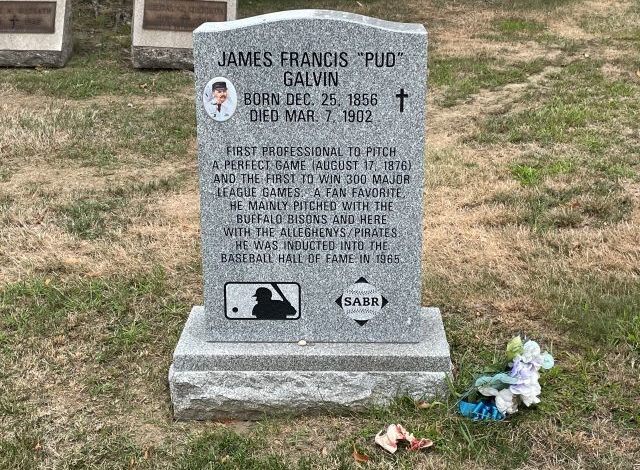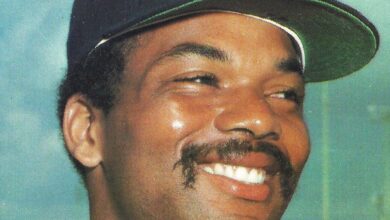
James “Pud” Galvin was a right-handed major-league pitcher during the years 1875 and 1879-92, mostly with the Buffalo Bisons and Pittsburgh Alleghenys, which later changed its name to the Pirates in 1891 when he returned after a year in the Players League. Galvin was the first pitcher to win 300 games. Heck, he was nearly a third of the way there based on the 1883 and 1884 seasons alone, when he won an astounding 46 games each year. In 1883, he led the major leagues with 76 appearances, 75 starts and 72 complete games. In 1884, he started 72 games, 71 of which were complete games, and led the majors with 12 shutouts.
Galvin pitched two no-hitters, on August 20, 1880 and August 4, 1884. Both made major-league history. The first was the first no-hitter by a visiting team. The second, an 18-0 victory over the Detroit Wolverines, was the most lopsided no-hitter. He was also the first pitcher to record a perfect game, on August 17, 1876 as a member of the St. Louis Red Stockings, an unaffiliated team not recognized as a major league team. August was apparently his favorite month.
Snubbed twice
Despite a career record of 365-310, a 2.85 ERA, 646 complete games, 57 shutouts and an amazing 1.1 walks per nine innings, Galvin was not elected to the Hall of Fame until 1965. More recently, he was snubbed again, left off the initial inaugural list of 19 inductees in the newly formed Pirates Hall of Fame announced earlier this season. Hopefully that injustice will be rectified in the near future.
Batters looking like pudding
Accounts differ as to how Galvin obtained the nickname “Pud.” Some say it was because he made the batters look like pudding. Some say it was due to his pudgy physique. In any event, the nickname was not used in any of the contemporary newspaper accounts I came across. Rather, he was referred to as James, Jimmy, Jimmie, “Jeems” or, later his career, “Old Man Galvin.”
Galvin’s record with the Alleghenys and Pirates was 126-110 compared to 218-179 with the Bisons. The Pittsburgh media largely absolved him of any blame for the lesser record. On June 14, 1888, the Pittsburgh Daily Post wrote, “Galvin is pitching a winning game, but no pitcher in the country could win with a team like the Pittsburghs to support him.”
Galvin’s 300th career win came on September 4, 1888 against the Indianapolis Hoosiers by a score of 5-4. The Pittsburgh Commercial Gazette wrote as though Galvin were more lucky than good on that day. The milestone was not mentioned.
“One of the trickiest pitchers in the profession”
However, mostly the newspapers back the notion that Galvin had lost nothing since coming from Buffalo to Pittsburgh in 1885. On April 17, 1888, for example, the Daily Post wrote of what must have been an exhibition tune-up against a team from Toronto, “The ‘old man’ showed up with all the sprightliness and vigor of youth. He swung his arms with the rapidity of yore and the ball shot across the plate with the speed that amazed the visitors from Her Majesty Victoria’s dominion . . . The veteran is nothing if he is not speedy.”
The April 8, 1889 Cincinnati Enquirer was equally effusive in its praise for Galvin. “Cincinnati patrons who saw the jolly pitcher play here with the Pittsburghs last week will agree with the writer that he is to-day [sic] one of the trickiest pitchers in the profession. Jimmie not only uses his arm, but his head plays a prominent part in his effective work. He studies his batters, and his judgment of pace is wonderful. Jimmie can put a speedy ball across the plate with the same motion he does a slow one. He has wonderful command of the ball, and the absence of preliminary movements so common to other pitchers contribute [sic] not a little to deceive a batsman.”
A “common drunkard?”
Galvin had a reputation for kindness and a sunny disposition, but of course wasn’t perfect. An amusing August 9, 1890 account in the Daily Post reported on what passed for a scandal in those days. “Seven players for the Pittsburgh team were publicly accused of being in no condition to play ball on account of excessive drinking” on the previous day. “The greatest surprise was that Galvin and [Bill] Kuehne were among the black sheep. Galvin up to date, has always borne the reputation of a steady man. No one has ever before accused Jimmy of being a common drunkard. And be it said there are very few who believe it.” This was the year Galvin spent with the Pittsburgh Burghers of the short-lived Players League.
Upon returning to the newly named Pirates in 1891, Galvin appeared to have lost none of his ability. For example, there was his victory over the New York Giants, 14-6, on June 11. Despite giving up six runs, the Daily Post reported “old man Galvin pitched a cyclone. It mattered not whether he sent in an up curve or a down twist, the sphere left his hand with such speed that the long bats of the Giants seemed hypnotized.”
“The club traded me to save a little money.”
Galvin’s time with the Pirates came to a sad, sudden end with his trade to the St. Louis Browns in the middle of the 1892 season, his final season in the major leagues. The June 17, 1892 Daily Post broke the news thusly: “Galvin’s retirement is forced; not only against his own protest, but against the wishes and protests of tens of thousands of base ball patrons and patriotic citizens generally. Mr. Galvin leaves to-night [sic] at 12 o’clock for St. Louis, and in him St. Louis gains the most popular player in the United States. He would have gone last night, but his laundry was not ready.”
The unnamed reporter sought Galvin out at his home, encountering an “angry” Mrs. Galvin who “did not like the arrangement, and . . . expressed her opinion of the Pittsburgh ball association quite freely.” The pitcher himself was found a block away, surrounded by neighbors returning home from shifts at the steel mill. All wished Galvin well, vowing never to attend another game in Pittsburgh, except to see him pitch for the opposition.
Galvin’s explanation of the trade will resonate all-too familiarly with Pirates fans 130 years later. “The club traded me off for two men to save a little money. They want a pitcher whom they can get for $80 a month. I can make more than that peddling matches.”
An untimely demise
Galvin passed away in 1902 at the age of 45. He died poor despite his success on the diamond.
My interest in Galvin was piqued during one of my semi-monthly visits to Calvary Cemetery, a Catholic cemetery in Pittsburgh near my home. Normally, I visit almost three dozen relatives’ graves there. I cover a lot of ground. In my wanderings I’ve come across the graves of Frank Gorshin, the actor/comedian who played the Riddler on the Batman TV series of the 1960s, and boxing legends Billy Conn and Harry Greb. Two weeks ago, in the baby section I discovered the grave of a cousin I didn’t know I had. It caused me to look up who else may be buried there. Thus yesterday’s search for Galvin’s grave.
Searching for the grave
After my usual rounds, I drove about the 200-acre cemetery, following the cemetery map on my phone, with the Dexter Gordon and Wardell Gray wild bebop classic, “The Hunt,” blaring from the car’s CD player. Galvin is buried in Section D, a lonely section where the decedents died so long ago, anybody who would be visiting their graves would be long dead themselves. Trees line the roadside and offered some welcome shade. The hot Pittsburgh summer, which yielded some rain but never enough, had turned large patches of the grass into straw. The ground was hard.
I walked up and down the expansive section and had almost given up when I spotted Galvin’s grave. It is surely not the same headstone he was first buried with. A modern gravestone stands there now. One notices Galvin’s picture and logos for Major League Baseball and The Society for American Baseball Research (SABR). His baseball accomplishments are listed there, too. I should have found it right away. The gravestone stands out among the older, plain, rusted-iron grave markers in Section D. Two other Galvins are buried nearby.
As I stepped back 15 feet to take a photo, on the ground I spotted the cover of a baseball. It would have thrilled me to a ridiculous extent if it were laying right near the grave. Journalistic integrity demands I inform you that I kicked it to the front of the grave before snapping the picture.
“His life has been the history of professional baseball”
The Daily Post report concluded, “He has always been considered steady and reliable, and at times very brilliant as a pitcher. His presence in the box inspired confidence, and the applause he has won would turn an actor’s head. He is filled with native humor, and when at his best can entertain the grand stand even with the game against him. He has fairly won about all the honors that ever came to a ball player, and he is brimful of good plays yet. His life has been the history of professional baseball, and it will probably continue to be for several years to come.”





